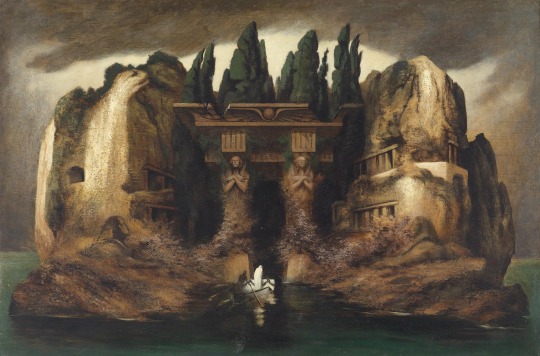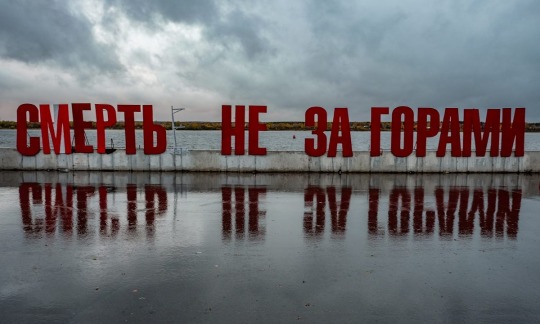Text

«Isle of the Dead» («Toteninsel») by Karl Wilhelm Diefenbach, 1900.
Karl Wilhelm Diefenbacn (1851-1913) was a German symbolist also known as a radical social reformist. During his period of studying at Munich Academy of Art he was inspired by the art of the Swiss symbolist Arnold Böcklin. It significantly influenced the following works of Diefenbach which became more dark and mystical.
The painting «Isle of the Dead», or «Toteninsel» was inspired by the eponymous work of Bocklin. It can be called an homage to Böcklin’s painting and it is almost copying its motif and composition. Here we also can see figures floating towards the lonely monumental island. There is the dark colored rower which looks like a shadow and the bright white figure leaning over the coffin. Here again we see the Böcklin’s cypresses (symbol of grief, cypresses often grow on cemeteries in Southern climate), the rocky base of the island without any grass or other trees and the tombs embedded into the rocks.
Although here instead of the Ancient Greek motifs in the architecture of Böcklin’s tombs Diefenbach uses also the Egyptian architecture and motifs. He put two sphinx between the sides of the island and also two figures with crossed arms on their chests like the mummies as if all they are protecting the dark entrance from the living.
#isle of death#arnold bocklin#bocklin#karl wilhelm diefenbach#diefenbach#death and dying#deaths and fatalities#symbolism
10 notes
·
View notes
Text

«The Old Man and Death» by Joseph Wright of Derby, c. 1775.
Wright’s painting «The Old Man and Death» is based on the fable written by Jean de La Fontaine (1621-1695). This fable was very popular at the end of the 18th century. It tells how an old tired man couldn’t raise a bundle of firewood and called for death. But when the dreadful Death appeared he got scared and regretted his careless wish.
Joseph Wright showed the culmination of the fable when the old man sees the Death and realizes the tragic consequences of his desire. The unsettling landscape, vivid colors and shrill brush strokes even enhance the emotions of this poor man.
Here as the author of the fable the artist doubts and even mocks the belief in power of the mind which was common at the 18th century. This painting can therefore be called the metaphor of the Age of Enlightenment.
1 note
·
View note
Text

«The Cemetery Entrance» by Caspar David Friedrich, 1825.
Caspar David Friedrich was a 19th Century Romantic landscape painter best known for the allegorical landscapes of his mid-period art, some of which radiate the overwhelming loneliness. Images of cemeteries deserve special attention. Some art historians associate these works and his tendency to draw lonely landscapes to the losses which Friedrich suffered during his life. It is also known that he had several depression periods which lead to the noticeable thematic shifts.
“The Cemetery Entrance” is an unfinished painting which Friedrich started in 1925, right at one of his depression periods. Here we see the monumental gates which look like the barrier between the world of life and the world of death. This feeling is even emphasized by a pair of figures who look in the depths of the cemetery as if afraid to step inside.
Depicted cemetery is painted on the basis of the Dresden Trinity Cemetery where Friedrich would be buried in 1940. The difference is in the landscape which was slightly changed by the artist. While Trinity Cemetery has a flat landscape, in the painting Friedrich had drawn the rolling hills which made the whole landscape deeper. The decorations of the gates were made on the basis of his own studies of the tombstones.
What I also want to emphasize is the crown of thorns on the gates which refers to the sufferings of Christ and his further resurrection. This means that Friedrich’s understanding of death is closely related to the resurrection of the soul.
Furthermore there are some more heroes in this painting. There is an angel on the center and two angels cressing two tombstones near the entrance. This looks like the artist decided to put grace right at the center of the cemetery, the place of death.
5 notes
·
View notes
Text


«Смерть не за горами» by Alexey Ilkaev («Sad Face»), 2018.
The installation «Смерть не за горами» (Perm, Russia) can be considered as an act of vandalism as well as an art object because it was made by an artist who actually transformed another installation «Счастье не за горами» by changing the first word. This change has completely transformed not just the physical form of an object but its whole meaning.
The original installation by Boris Matrosov (2018) is called «Счастье не за горами» (second picture) which can be translated as «Happiness is just around the corner», or «The best is yet to come».
After the Ilkaev’s transformation (he replaced the word «happiness» with «death») the meaning changed to «Death is just around the corner», or «The death is yet to come» (first picture).
The artist said that with this action he wanted to draw attention to the meaning of this phrase. He thinks that death as an existential category is undeservedly displaced outside the framework of our everyday lives in modern society.
0 notes
Text

«Elaine» by Toby Edward Rosenthal, 1874.
Elaine is a hero from the 19th century version of the Arthurian legend “Idylls of the King” written by Lord Alfred Tennyson. She died of a broken heart when she was spurned by Sir Lancelot. Rosenthal depicted her in her post-mortem voyage to Camelot in a Pre-Raphaelites manner.
After this work was shown on an exhibit the figure of Elaine became very popular. There were formed clubs, made art in her honour, and all the copies of this version of the legend were sold out.
#symbolism#pre raphaelite#Toby Rosenthal#rosenthal#Elaine#lancelot#death of the maiden#death#death and dying#artist#painting#fine art
3 notes
·
View notes
Text

«Allegory of the Redemption» by Jacopo Ligozzi, ca. 1587. Museo del Prado, Madrid.
Jacopo Ligozzi was an Italian artist whose art can be characterised as late-Renaissance and Mannerist styles.
He is mostly knows for his allegories including numerous allegories of death where he used morbid language which included skeletons, sculls and other symbols.
5 notes
·
View notes